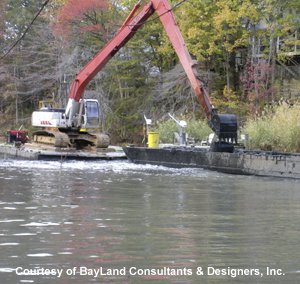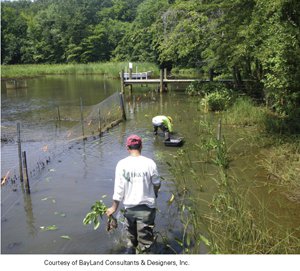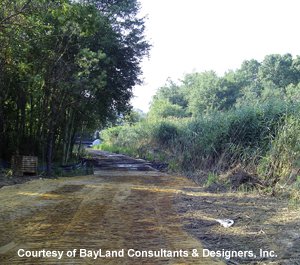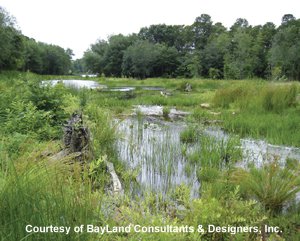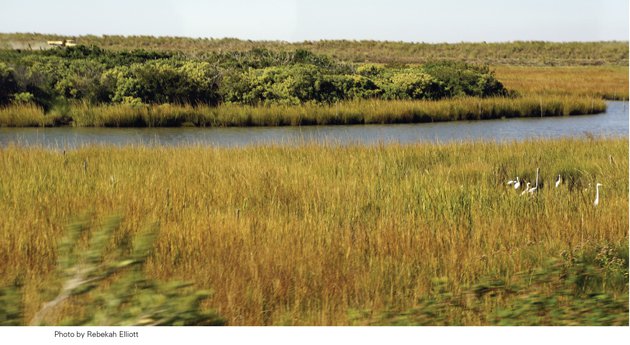Poplar Island was rebuilt by the U.S. Army Corps of Engineers using locally dredged material, which provided a foundation on which island habitat was restored. The project is an excellent example of how material dredged from waterways is used to benefit habitat projects. --Photo by Rebekah Elliott
By LISA A. LEWIS
In October 2010, BayLand Consultants & Designers, Inc. completed a project to integrate water quality, ecological enhancement, and dredging restoration for the Mill Creek headwaters in Arnold. Contracted by the Anne Arundel County Department of Public Works (DPW), BayLand prepared a comprehensive plan to restore and expedite recovery of the tidal headwaters. The Mill Creek Headwaters Restoration Project included environmental dredging, intertidal marsh creation, submerged aquatic vegetation enhancement, and upland retrofits. The first stage of the project was completed in December 2010. Other aspects of the project, such as constructing the living shoreline in the headwaters, planting native species in the waterway, and planting underwater grasses, were completed in the spring of 2011. BayLand will continue to monitor the project through 2016 to evaluate its long-term success.
Dredging projects such as these aren’t uncommon. According to the Anne Arundel County DPW, at any given time, at least 20 projects are on the county’s waterway improvement project list awaiting completion. After all, dredging is an indispensable industry, and it’s vital to the county’s waterways and economy.
“Anne Arundel County is home to nearly 25 percent of Maryland’s recreational boating population—the most in the state and twice that of the next largest (county), Baltimore County,” says Keith D. Tate, P.E., president/founder of BayLand Consultants & Designers Inc. and senior project manager for dredging and environmental restoration.
“Recreational boating is an important component of the county’s social, cultural, historic, and economic fiber.”
It’s estimated that Anne Arundel County boaters generate up to $400 million in annual boating-related expenditures, which secures nearly 7,000 jobs in the county, Tate says. “To support this level of activity and boating demand, the county developed a Waterway Improvement Program that maintains and improves the 163 navigable waterways located within the 10 main river systems that connect to the Chesapeake Bay,” he says. Navigation channels range from three to eight feet deep and up to 75 feet wide to accommodate sailing and powerboats that frequent the waterways.
Most Anne Arundel County residents probably understand the importance of dredging and why it’s necessary. Dredging removes sediments—clay, silt, mud—from the bottom of waterways to deepen or widen them, keeping them clear and safe for navigation. What residents may not realize, however, is how dredging is actually done, how it affects aquatic habitats, and how—whenever possible—dredging is used to benefit the environment, as in the case of the Mill Creek Headwaters Restoration Project, or on a much larger scale such as the rebuilding of Poplar Island, located in Talbot County.
History of Dredging
Dredging has existed since ancient times. According to the Handbook of Dredging Engineering, Second Edition by John B. Herbich, primitive dredging can be traced back several thousand years to the Nile, Tigris, Euphrates, and Indus rivers. The earliest methods were dependent on manpower. Men worked in groups to “excavate” the bottom of waterways. Records indicate that early dredging also was done using horses to pull buckets that scooped up sediments. But as time passed, people began to seek easier, more efficient methods—first in the form of a steam engine and then a centrifugal pump, the precursor to the modern-day hydraulic hopper dredge.
Dredging is a lengthy process. The Anne Arundel County DPW estimates that an average project takes 36 months to complete. Various time frames for dredging have been established to protect estuarine and marine life and shellfish harvesting. However, the majority of dredging projects can typically be completed between October 15th and Fe uary 14th, when they won’t interfere with recreational boating or disturb aquatic habitats. Once a waterway is dredged, it ideally lasts 10 to 15 years before additional dredging is necessary.
Modern Methods of Dredging
Two types of dredges are used in Anne Arundel County: mechanical and hydraulic. Mechanical dredges scoop material from the bottom of the waterway with an excavator (a machine that resembles a backhoe) mounted on a barge. The dredged material is placed on another barge, taken to shore, and transported to a dredged material placement (DMP) site. Hydraulic dredges remove sediment using suction. An underwater pipe sucks the material through one end and deposits it directly into the DMP site.
“In Anne Arundel County, more than 80 percent of dredging projects are typically completed using mechanical dredging,” says Masoud Ghatineh, P.E., dredging project manager for the Anne Arundel County DPW’s Bureau of
Engineering. “Hydraulic dredging is more efficient and economical since the dredged material goes directly to the DMP. But the up-front cost of hydraulic dredging is expensive, so it’s typically only used for large projects and only accounts for about 20 percent of the county’s dredging projects. Another requirement for hydraulic dredging is the availability of a nearby DMP site.”
Although many people may think that dredged material is contaminated because of its black color and consistency—earning it the name “black mayonnaise” by workers in the industry—this is not the case.
“Dredged material can look and smell like muck, but we have to remember that it’s soil that has washed from the land surrounding our waterways,” Tate says. “When properly tested and managed, it’s able to be dried and returned to a soil material, particularly sediment within Anne Arundel County’s waterways.”
Environmental Concerns
In the past, dredging was done without regard for the environment. Dredged material was thrown overboard into open water, adversely affecting water quality and aquatic life, and destroying vital habitat. According to Captain Diana Muller, South Riverkeeper at the South River Federation, dredging can affect turbidity, which, in turn, can harm oyster populations. To prevent any damage from occurring, today’s process requires special permits for dredging near oyster beds—all of which are mapped—and implements a 500-foot barrier between the workers and the oyster beds so their habitat is not destroyed. Underwater grasses also are mapped to avoid habitat disruption.
Turbidity can affect water quality, as well, making water testing a critical process. Despite mapping high-risk areas and taking the necessary precautions to protect aquatic habitats and monitor water quality, dredging is still not permitted in certain areas.
“Each case is different, and it depends on the circumstances and the specific area,” says Muller, who monitors the tidal portion of the South River on a weekly basis and tests the water quality. “But if it will change the symmetry of the area, or if it’s harmful to the aquatic ecosystem, dredging shouldn’t be done.”
In addition to the method of dredging, today’s equipment must also be environmentally friendly. Technological advances have been made to ensure that there are no environmental impacts and that the machinery doesn’t pose a threat to aquatic habitats.
“From a machinery standpoint, there are several eco-friendly options incorporated in the dredge design, including biodegradable hydraulic fluids that won’t harm the environment if there is a leak, low noise engine packages to reduce environmental disturbances, and EPA-compliant engines that emit low emissions,” Miller says.
Beneficial Use
Perhaps one of the most unique aspects of dredging is beneficial use—using dredged material to benefit the environment. Beneficial use projects include the creation of wetlands, woodlands, marshlands, and wildlife habitats, as well as beach nourishment (rebuilding shoreline erosion). Tate says Anne Arundel County residents are fortunate that the vast majority of material dredged is used for county projects, including the Beverly-Triton Beach Shoreline Stabilization Project in central county and the North Grays Bog Wetland Restoration Project in north county.
Beneficial use is the preferred method of managing dredged material and is the primary goal in Anne Arundel County. However, beneficial use projects must meet strict requirements. If the dredged material doesn’t meet these requirements, it must be stored at a DMP site.
Clearly, dredging has evolved a great deal throughout the years and has made great strides during its long and varied history. Once viewed as a “necessary evil” that was done to remove and dispose of “waste” using methods that harmed the environment, dredging is now perceived as an invaluable industry—a beneficial procedure that keeps Anne Arundel County’s waterways navigable and also enriches the environment.
“(In terms of dredging), we have come a long way,” Tate says. “And after all the engineering, permitting, design, and construction are over, it’s rewarding to see both the people and the wildlife return to enjoy their creek again.”
